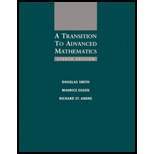
a.
To indicate whether the Axiom of choice must be employed to select one element from each set in the following collections.
a.
Explanation of Solution
Given:
Consider the infinite collection of sets, each set containing one odd and one even integer.
Calculation:
Since, in the infinite collection of the sets, each set containing one odd and one even integer that is each set in the infinite collection is nonempty and finite
Then, the collection is infinite collection of nonempty sets but its sets are finite
Since, the Axiom of Choice is that if
Therefore, there is no need the Axiom of Choice to select one element from each set in the collection.
Hence, there is no need to employ the Axiom of Choice.
b.
To indicate whether the Axiom of Choice must be employed.
b.
Explanation of Solution
Given:
Consider the finite collection of sets such that each set is uncountable
Calculation:
Since, in the infinite collection of the sets, each set containing one odd and one even integer that is each set in the infinite collection is nonempty and finite
Then, the collection is infinite collection of nonempty sets but its sets are finite
Since, the Axiom of Choice is that if
Therefore, there is no need the Axiom of Choice to select one element from each set in the collection.
Hence, there is no need to employ the Axiom of Choice.
c.
To indicate whether the Axiom of Choice must be employed.
c.
Explanation of Solution
Given:
Consider the infinite collection of sets each containing exactly four natural numbers.
Calculation:
Since, in the infinite collection of the sets, each set containing one odd and one even integer that is each set in the infinite collection is nonempty and finite
Then, the collection is infinite collection of nonempty sets but its sets are finite
Since, the Axiom of Choice is that if
Therefore, there is no need the Axiom of Choice to select one element from each set in the collection.
Hence, there is no need to employ the Axiom of Choice.
d.
To indicate whether the Axiom of Choice must be employed.
d.
Explanation of Solution
Given:
Consider the denumerable collection of uncountable sets.
Calculation:
Since, the collection is denumerable collection of uncountable sets.
Then, the collection of sets is infinite and sets are also infinite.
Since, the Axiom of Choice is that if
Therefore, there is need of the Axiom of Choice to select one element from each set in the collection.
Hence, it is necessary to employ the Axiom of Choice.
e.
To indicate whether the Axiom of Choice must be employed.
e.
Explanation of Solution
Given:
Consider the collection of following sets-
Where
Calculation:
Since the set of natural numbers are infinite.
Then, the collection of sets is infinite and sets are also infinite.
Since, the Axiom of Choice is that if
Therefore, there is need of the Axiom of Choice to select one element from each set in the collection.
Hence, it is necessary to employ the Axiom of Choice.
f.
To indicate whether the Axiom of Choice must be employed.
f.
Explanation of Solution
Given:
Consider the following collection of sets
Calculation:
Then, the collection of sets is infinite and sets are also infinite.
Since, the Axiom of Choice is that if
Therefore, there is need of the Axiom of Choice to select one element from each set in the collection.
Hence, it is necessary to employ the Axiom of Choice.
g.
To indicate whether the Axiom of Choice must be employed.
g.
Explanation of Solution
Given:
Consider the following collection of sets
Calculation:
Then, the collection of sets is infinite and sets are also infinite.
Since, the Axiom of Choice is that if
Therefore, there is need of the Axiom of Choice to select one element from each set in the collection.
Hence, it is necessary to employ the Axiom of Choice.
h.
To indicate whether the Axiom of Choice must be employed.
h.
Explanation of Solution
Given:
Consider the following collection of sets
Calculation:
Since, in the collection of sets, each set in A is infinite.
Then, the collection of sets is infinite and sets are also infinite.
Since, the Axiom of Choice is that if
Therefore, there is need of the Axiom of Choice to select one element from each set in the collection.
Hence, it is necessary to employ the Axiom of Choice.
Want to see more full solutions like this?
Chapter 5 Solutions
A Transition to Advanced Mathematics
- Algebra & Trigonometry with Analytic GeometryAlgebraISBN:9781133382119Author:SwokowskiPublisher:Cengage
 Elements Of Modern AlgebraAlgebraISBN:9781285463230Author:Gilbert, Linda, JimmiePublisher:Cengage Learning,
Elements Of Modern AlgebraAlgebraISBN:9781285463230Author:Gilbert, Linda, JimmiePublisher:Cengage Learning,

